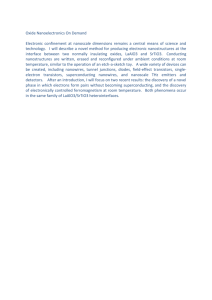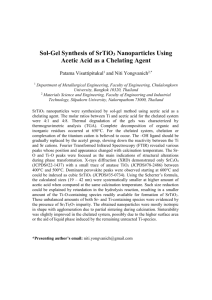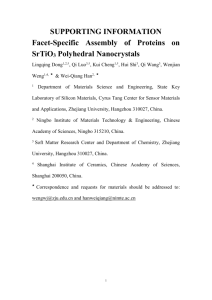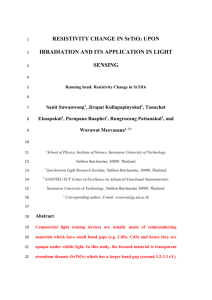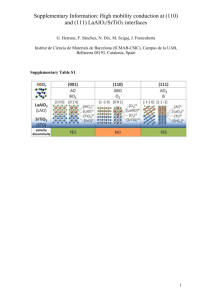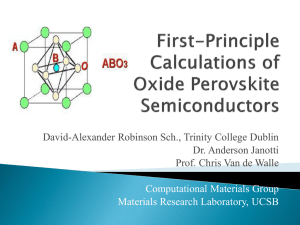resistivity change
advertisement
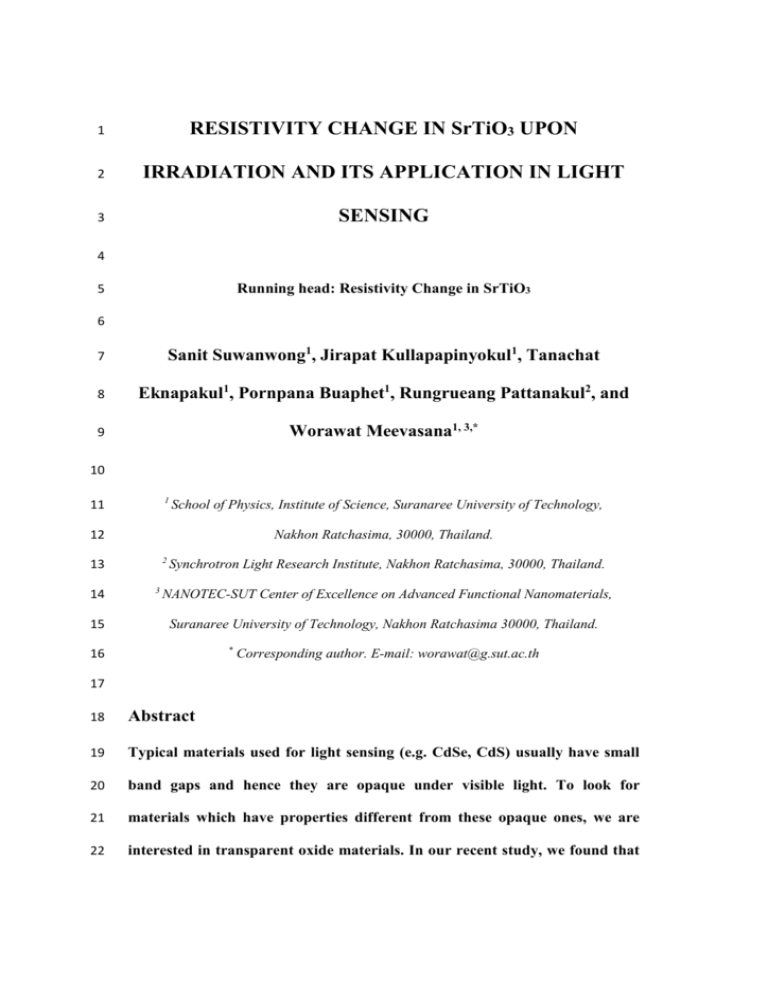
1 RESISTIVITY CHANGE IN SrTiO3 UPON 2 IRRADIATION AND ITS APPLICATION IN LIGHT 3 SENSING 4 5 Running head: Resistivity Change in SrTiO3 6 7 Sanit Suwanwong1, Jirapat Kullapapinyokul1, Tanachat 8 Eknapakul1, Pornpana Buaphet1, Rungrueang Pattanakul2, and 9 Worawat Meevasana1, 3,* 10 1 11 School of Physics, Institute of Science, Suranaree University of Technology, 12 Nakhon Ratchasima, 30000, Thailand. 2 13 14 15 3 Synchrotron Light Research Institute, Nakhon Ratchasima, 30000, Thailand. NANOTEC-SUT Center of Excellence on Advanced Functional Nanomaterials, Suranaree University of Technology, Nakhon Ratchasima 30000, Thailand. * 16 Corresponding author. E-mail: worawat@g.sut.ac.th 17 18 Abstract 19 Typical materials used for light sensing (e.g. CdSe, CdS) usually have small 20 band gaps and hence they are opaque under visible light. To look for 21 materials which have properties different from these opaque ones, we are 22 interested in transparent oxide materials. In our recent study, we found that 2 23 the insulating surfaces of strontium titanate (SrTiO3) crystals in vacuum 24 condition could become conducting upon synchrotron radiation. In this 25 article, we then choose to study the resistivity change of SrTiO3 at ambient 26 pressure under various types of irradiation. By using sputtering technique 27 for making gold electrodes on SrTiO3 samples, we found that the resistance 28 of insulating SrTiO3 single crystals could decrease dramatically upon 29 exposing to violet-to-ultraviolet (UV) light sources. The light sources which 30 the samples have good response are deuterium lamp and UV light emitting 31 diode (LED) where the ratio change was found to be up to 3 orders of 32 magnitude. The response times of the resistivity change when the light 33 sources were on and off were found to be clearly different (e.g. 12 ms (on) 34 versus 480 ms (off)); however, these response times can be tuned externally 35 by further modifying the circuit. These results indicate that SrTiO3 has the 36 potential usage as a light sensor which is transparent and responsive in 37 violet-to-ultraviolet range. 38 39 40 Keywords: strontium titanate (SrTiO3), light sensing, irradiation effect, oxygen vacancy 41 42 Introduction 43 Today’s electronic devices rely largely on the semiconducting properties of 44 materials. While the progress of new development using conventional 45 semiconductors (e.g. silicon) nearly reaches its limit, new materials (e.g. 2 3 46 graphene) have been studied to overcome the problem (Geim and Novoselov, 47 2007). Besides graphene, two-dimensional electron gases (2DEG) at oxide 48 interfaces (Takagi and Hwang, 2010; Mannhart and Schlom, 2010) also show 49 much potential for electronic devices with functionalities beyond what 50 conventional semiconductors can offer. The seminally-discovered 2DEGs at the 51 interfaces between SrTiO3 and LaAlO3 show a number of appealing properties 52 including, a high electron mobility (Ohtomo and Hwang, 2004), superconductivity 53 (Reyren et al., 2007) and large magnetoresistance (Brinkman et al., 2007). Indeed, 54 metal-insulator switching devices in nanoscale have already been demonstrated 55 (Cen et al., 2008). From our previous studies, we also found that the charge 56 densities of 2DEGs at oxide surfaces, e.g. SrTiO3 (Meevasana et al., 2011) and 57 KTaO3 (King et al., 2012), can respond on external stimuli, like irradiations. We 58 also show that the dielectric constant of CaCu3Ti4O12 could be enhanced upon 59 excitation of violet laser (Masingboon et al., 2013), suggesting some application 60 in novel oxide optoelectronics. 61 In this article, we are interested in light-sensing application, using 62 perovskite oxide SrTiO3. Since most of common light sensors use small-band-gap 63 semiconductors, e.g. CdS and CdSe with band gaps of 2.42 and 1.73 eV 64 respectively (Mohanchandra and Uchil, 1998; Antohe et al., 2003), they are 65 opaque. On the other hand, since SrTiO3 with atomic structure shown in Figure 66 1(a) has wider band gap of 3.3 eV (Benthem et al., 2001), it is transparent (see 67 Figure 1(b)) making it possible to be used as a component in transparent 68 electronics. Importantly, the wide-band-gap SrTiO3 could respond better to UV 3 4 69 light comparing to conventional semiconductors and hence this could be useful in 70 civil and military applications with the need of ultraviolet detectors (Xing et al., 71 2007). While the SrTiO3-based UV detector has been shown possible, here, we 72 have investigated further in the response to various types of available light 73 sources, including sunlight. The response time periods of on-off switching are 74 measured and discussed; furthermore, we also show that this response time can be 75 modified by externally modifying the circuit. 76 77 Materials and Methods 78 Sample preparation and resistance measurement 79 SrTiO3 samples measured in the work (Crystal Base Co., Japan) are single 80 crystals with (100) crystal orientation and 550.5 mm3 in dimension. The 81 samples are first cleaned with KI/I2 (KI: I2: H2O = 10 g: 2.5 g: 100 ml), and then 82 rinsed with water, acetone and ethanol. We then make gold electrode patterns on 83 the sample surfaces by using DC sputtering coater. As shown in Fig. 1(c)-1(d) the 84 SrTiO3 surface is covered by gold films except in the middle part whose width is 85 around 147 m. 86 This middle area of SrTiO3 surface, which is initially insulating without 87 any excitation, will later be exposed to various types of irradiation, including 88 violet laser (405 nm), green laser (530 nm), red laser (650 nm), ultraviolet light 89 emitting diode (LED), deuterium lamp (Ocean Optics DH-2000), halogen lamp 90 (Ocean Optics DH-2000), and sunlight. To observe the change at the SrTiO3 91 surface after being irradiated, we measure the surface resistance by Agilent source 4 5 92 meter (model: B2901A). The setup diagram is shown in the inset of Fig. 2(a) and 93 Fig. 2(d). For sunlight, we also measure the change under both normal and 94 focusing conditions. To focus the sunlight, we use magnifying glass with 14 cm in 95 diameter; the size of partially focused spot is around 0.8 cm in diameter. 96 97 Results and Discussion 98 As shown in Fig. 2(a), we observe a pronounced change in surface 99 resistance when the sample is exposed to violet laser with intensity around 708.53 100 W/m2. The original surface resistance is around 20 G and then decreases quickly 101 to around 200 M after turning on the violet laser. After turning off the violet 102 laser, the resistance increases back close to the original value but at noticeably 103 slower rate. The zoom-in periods during turning on and off the laser are shown in 104 Fig. 2(b) and 2(c). By defining the response time to be the period which resistance 105 changes half way to the saturate value, the response times after turning on and off 106 are around 11.94 ms and 480 ms respectively. 107 This resistance drop, when light is on, could be caused by several effects, 108 including photoconductivity (Jiang and Hasegawa, 1999), photoelectric effect 109 (Sorokin et al., 2007) and the creation of oxygen vacancies at surface (Meevasana 110 et al., 2011; King et al., 2012). For the photoconductivity and photoelectric effect, 111 the resistance should recover quickly after turning off the light. However, for the 112 oxygen vacancy effect, it could last much longer after turning off the light; the 113 recovery rate could last very long in order of hours, especially under vacuum 114 condition (Meevasana et al., 2011). In our case, the recovery takes very long in 5 6 115 order of 480 ms from the observed response time (see Fig. 2(c)). This suggests 116 that the oxygen vacancy effect has the major role in this change; however, we 117 should note that we believe that photoconductivity and photoelectric effect could 118 still affect the change but in the lesser degree. 119 Technically, some application which needs the response times between on 120 and off to be in the same order could suffer from this much difference we observe 121 here (e.g. 11.94 ms versus 480 ms in Fig. 2(b) and 2(c)). Therefore, we investigate 122 further and found that indeed, this difference can be adjusted by external tuning. 123 As shown in Fig. 2(d)-2(f), after we connect a 118 M resistor in parallel to the 124 SrTiO3 sample (see inset of Fig. 2(d)), the response times, when turning on and 125 off, change to 14.35 ms and 24.78 ms in Fig. 2(e) and 2(f), respectively. However, 126 there is a trade-off effect; although the response time for turning off is reduced 127 significantly, the effective changes in resistance also reduced largely and the 128 turning-on response time also increases slightly. 129 Besides the irradiation from violet laser, we also irradiate the SrTiO3 130 samples by using other various light sources, including red laser, green laser, UV 131 LED, deuterium lamp, halogen lamp and sunlight. The intensity spectra of these 132 light sources as a function of wavelength are shown in Figure 3(a). And the 133 responses in resistance after turning on and off the light sources are shown in 134 Figure 3(b); note that each change in resistance along y-axis is normalized by the 135 overall intensity of each light source. The changes in resistance per overall 136 intensity are high when using deuterium lamp and UV LED. This suggests that the 137 resistance change of SrTiO3 is more sensitive in UV range. Deuterium lamp has a 6 7 138 large spectral weight of wavelengths below 387 nm, i.e. photon energy higher 139 than band gap of 3.2 eV. For the violet laser, the wavelength is around 405 nm or 140 3.06 eV (just below the band gap); we can see that the change per intensity is 141 relatively much lower comparing to the two light sources above; this corresponds 142 quite well with the onset of spectral response of SrTiO3 (Xing et al., 2007). 143 We also investigate further to see the resistance change under different 144 intensity of sunlight as shown in Figure 4. In the measurement, we use a 145 magnifying glass to focus the sunlight and hence increase the intensity to around 146 4400.87 W/m2 while the unfocused intensity is 915.6 W/m2. We observe that the 147 resistance change (see Fig. 4) can largely depend on the intensity. When there is 148 no light, the resistance is around 23 GΩ. And, when there is sunlight, the 149 resistance drops to 6.23 GΩ under indoor light, 505.42 MΩ under unfocused light, 150 and 10 MΩ under focused light. This pronounced change and its variation 151 suggests that the SrTiO3 detector can also be used for detecting the intensity of 152 sunlight in quantitative level. The mapping of resistance change versus intensity 153 variation will be investigated further. While the samples here are single crystals, 154 in the future we are also interested in other titanium oxides prepared by various 155 methods, e.g. WO3 film (Paipitak et al., 2012) and BaTiO3 film (Hodak et al., 156 2010). 157 158 Conclusions 159 In this article, we show that the surface resistance of transparent SrTiO3 160 material could reduce largely under irradiation from various light sources, 7 8 161 especially deuterium lamp and UV LED. The intrinsic response times, when the 162 light is on and off, can be different around one order of magnitude but this 163 difference can be adjusted externally. We also show that the resistance change can 164 also largely depend on the sunlight intensity. These results promise the light- 165 sensing application of this transparent SrTiO3 material. 166 167 Acknowledgements 168 This work was supported by the Suranaree University of Technology (OROG) 169 and Office of Higher Education Commissions under NRU. 170 171 References 172 Antohe, S., Ion, L., and Antohe, V. A. (2003). The effect of the electron 173 irradiation on the structural and electrical properties of AII-BVI thin 174 polycrystalline films. Journal of Optoelectronics and Advanced Materials, 175 5(4):801-816. 176 Benthem, K. V., Elsasser, C., and French, R. H. (2001). Bulk electronic structure 177 of SrTiO3: Experiment and theory. Journal of applied physics, 178 90(12):6156-6164. 179 Brinkman, A., Huijben, M., Van Zalk, M., Huijben, J., Zeitler, U., Maan, J.C., 180 Van Der Wiel, W.G., Rijnders, G., Blank, D.H.A., and Hilgenkamp, H. 181 (2007). Magnetic effects at the interface between non-magnetic oxides. 182 Nature Materials, 6:493-496. 8 9 183 Cen, C., Thiel, S., Hammerl, G., Schneider, C.W., Andersen, K.E., Hellberg, C.S., 184 Mannhart, J., and Levy, J. (2008). Nanoscale control of an interfacial 185 metal-insulator transition at room temperature. Nature Materials, 7:298- 186 302. 187 188 Geim, A. K., and Novoselov, K. S. (2007). The rise of graphene. Nature Materials, 6:183-191. 189 Hodak, S. K., Supasai, T., Wisitsoraat, A. and Hodak, J. H. (2010. Design of low 190 cost gas sensor based on SrTiO3and BaTiO3 films. Journal of 191 Nanoscience and Nanotechnology, 10: 7236-7238. 192 193 Jiang, C. S., and Hasegawa, S. (1999). Photoconductivity of the Si(111)-7 x 7 and x -Ag surfaces. Surface Science, 427-428:239-244. 194 King, P.D.C., He, R.H., Eknapakul, T., Buaphet, P., Mo, S.-K., Kaneko, Y. 195 Harashima, S., Hikita, Y., Bahramy, M.S., Bell, C., Hussain, Z., 196 Tokura, Y., Shen, Z.-X., Hwang, H. Y., Baumberger, F., and 197 Meevasana, W. (2012). Subband structure of a two-dimensional electron 198 gas formed at the polar surface of the strong spin-orbit perovskite KTaO3. 199 Physics Review Letters, 108:117602. 200 201 Mannhart, J., and Schlom, D. G. (2010). Oxide Interfaces-An opportunity for electronics. Science, 327(5973):1607-1611. 202 Masingboon, C., Eknapakul, T., Suwanwong, S., Buaphet, P., Nakajima, H., 203 Mo, S.-K., Thongbai, P., King, P.D.C., Maensiri, S., and Meevasana, W. 204 (2013). Anomalous change in dielectric constant of CaCu3Ti4O12 under 205 violet-to-ultraviolet irradiation, Applied Physics Letters, 102:202903. 9 10 206 Meevasana, W., King, P.D.C., He, R. H., Mo, S.-K., Hashimoto, M., Tamai, A., 207 Songsiriritthigul, P., Baumberger, F., and Shen, Z.-X. (2011). Creation and 208 control of a two-dimensional electron liquid at the bare SrTiO3 surface. 209 Nature Materials, 10:114-118. 210 Mohanchandra, K.P., and Uchil, J. (1998). Electrical properties of CdS and CdSe 211 films deposited on vibrating substrates. Journal of Applied Physics, 212 84(1):306-310. 213 214 215 Ohtomo, A., and Hwang, H. (2004). A high-mobility electron gas at the LaAlO3/SrTiO3 heterointerface. Nature, 427:423-426. Paipitak, K., Rattanarak, J., Pakdeeyingyong, D., Techitdheera, W., 216 Porntheeraphat, S., and Pecharapa, W. (2012). Enhanced electrochromic 217 performance of sol-gel derived WO3 thin films assisted by electrospun 218 PVA nanofibers. Advanced Materials Research, 528: 249-253. 219 Reyren, N., Thiel, S., Caviglia, A.D., Fitting Kourkoutis, L., Hammerl, G., 220 Richter, C., Shneider, C.W., Kopp, T., R etschi, A.-S., Jaccard, D., 221 Gabay, M., Muller, D.A., Triscone, J.-M., and Mannhart, J. (2007). 222 Superconducting interfaces between insulating oxides. Science, 317:1196- 223 1199. 224 Sorokin, A. A., Bobashev, S. V., Feigl, T., Tiedtke, K., Wabnitz, H., and 225 Ritchter, M. (2007). Photoelectric effect at ultrahigh intensities. Physical 226 Review Letters, 99:213002. 227 228 Takagi, H., and Hwang, H. Y. (2010). An emergent change of phase for electronics. Science, 327(5973):1601-1602. 10 11 229 Xing, J., Zhao, K., Lu, H.B., Wang, X., Liu, G.Z., Jin, K.J., He, M., Wang, C.C., 230 and Yang, G.Z. (2007). Visible-blind, ultraviolet-sensitive photodetector 231 based on SrTiO3 single crystal, Optics Letters, 32(17):2526-2528. 232 11 12 233 234 Figure 1. SrTiO3 single crystal. (a) atomic structure of SrTiO3 sample (b) Transparency 235 of SrTiO3 single crystal (c-d) pattern of gold electrodes on the sample surface 236 by using DC sputtering coater. 12 13 237 238 Figure 2. (a) The resistance before and after violet laser exposure on SrTiO3. The inset 239 shows measurement setup in series. (b-c) The corresponding zoom-in periods 240 when violet laser is on and off. (d) The resistance before and after violet laser 241 exposure on SrTiO3 with 180 M resistor added in parallel (see inset). (e-f) 242 The corresponding zoom-in periods when violet laser is on and off. 13 14 243 244 Figure 3. (a) The intensity spectra of various light sources, including deuterium lamp, 245 UV LED, halogen lamp, violet laser, sunlight, green laser, and red laser as a 246 function of wavelength (the overall intensity for each light source is adjusted 247 to fit in the graph). (b) The responses in resistance after turning on and off the 248 light sources; note that each change in resistance is normalized by the overall 249 intensity of each light source. 14 15 250 251 252 Figure 4. The resistance before and after sunlight exposure on SrTiO3, using indoor, unfocused sunlight and focused sunlight. 15
